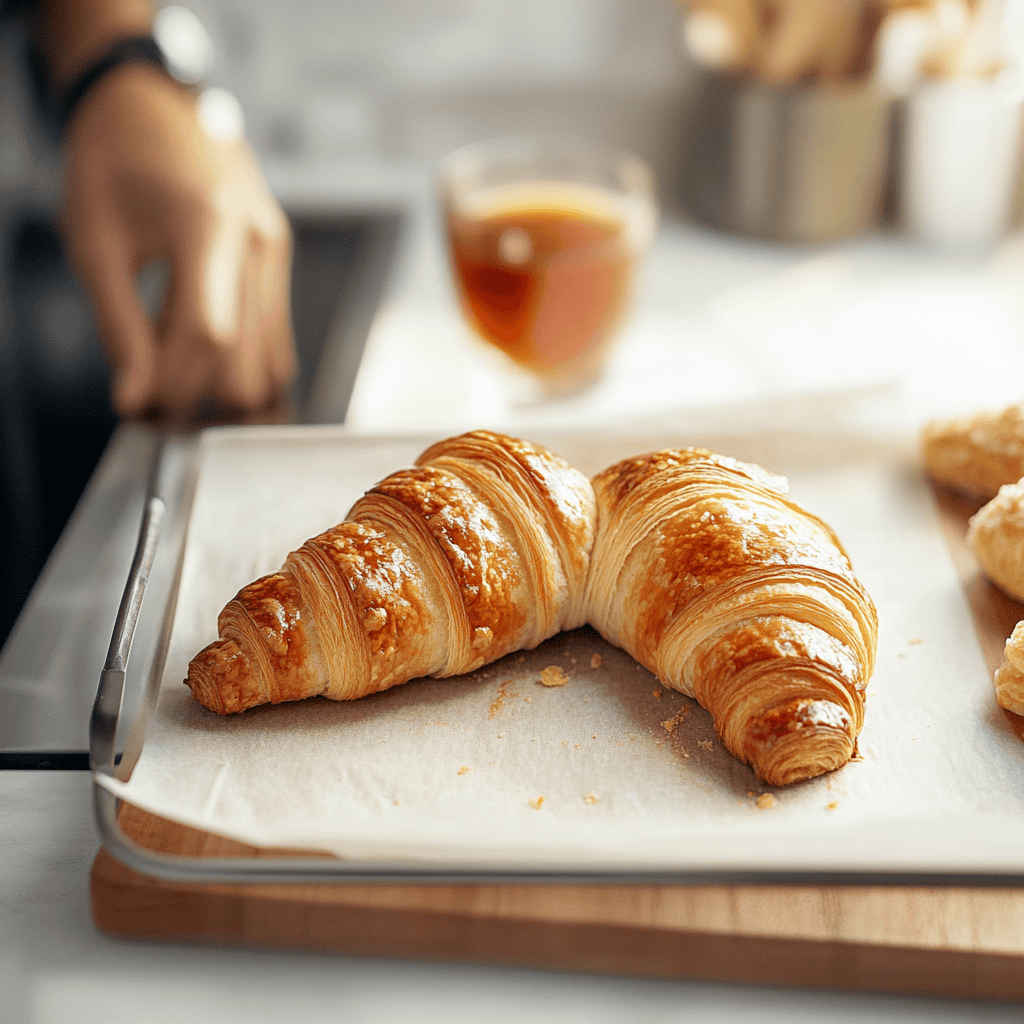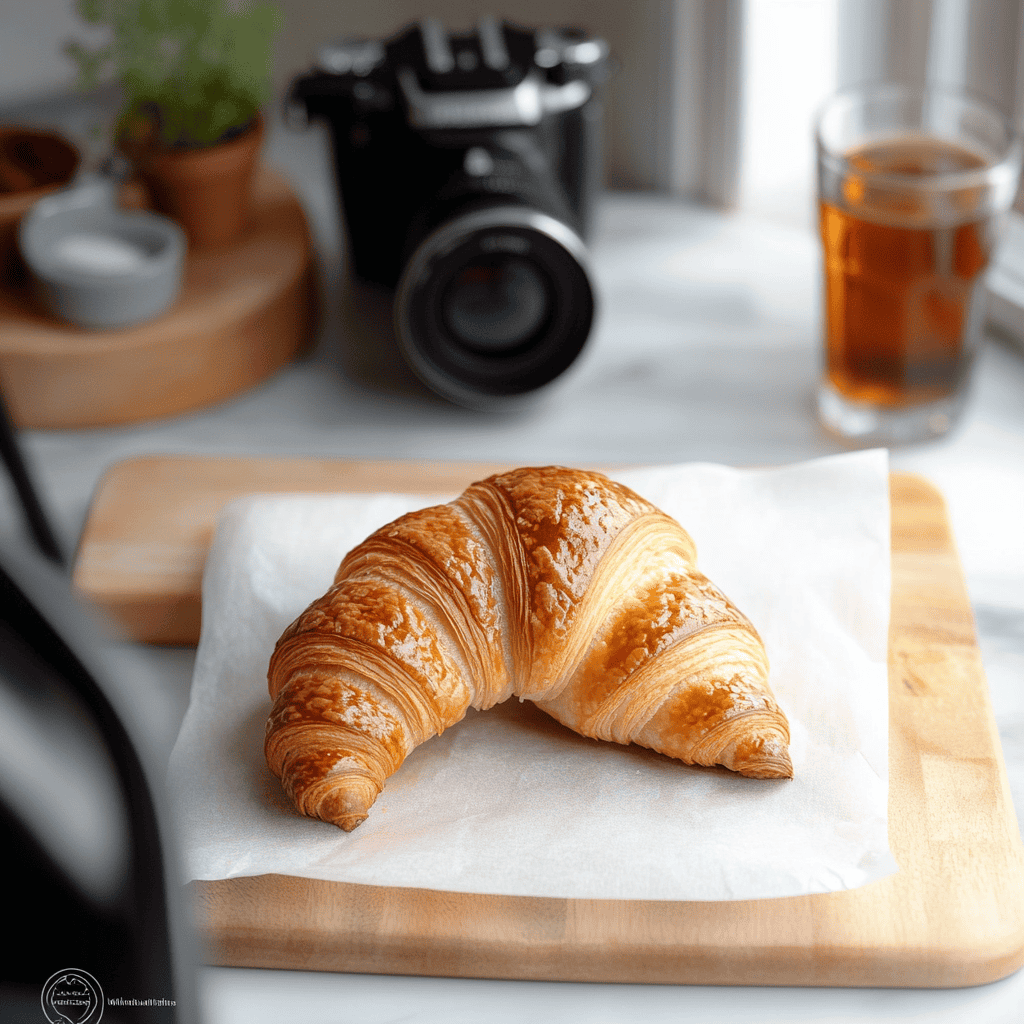Quick Overview
Are you ready to whip up some magic in your kitchen? Our homemade flaky croissants recipe will guide you through the process of creating these delightful pastries right at home. Imagine buttery layers melting in your mouth with every bite. Whether for breakfast or brunch, these croissants will impress family and friends alike. With a little patience and the right technique, you’ll master this classic French treat.
Ingredient Breakdown
Flour
For this homemade flaky croissants recipe, you will need 4 cups of all-purpose flour. This forms the base of your dough and contributes to the structure and texture of the final product. Ensure you measure accurately for the best results.
Butter
You will require 1 cup (2 sticks) of unsalted butter. The butter is crucial for creating those signature flaky layers. Be sure to use high-quality butter for optimal flavor.
Water
Use 1 cup of cold water in your dough mixture. Cold water helps keep the butter solid during mixing and rolling, which is vital for achieving that flakiness.
Sugar
Add 2 tablespoons of granulated sugar. Sugar not only enhances the flavor but also aids in browning during baking, giving your croissants a beautiful golden hue.
Yeast
You will need 2 teaspoons of active dry yeast. This ingredient is essential for leavening the dough and allowing it to rise properly.
Salt
Include 1 teaspoon of salt in your recipe. Salt balances out the sweetness and enhances the overall flavor profile of the croissants.
Step By step Recipe: Homemade Flaky Croissants Recipe
Step 1: Prepare the Dough
Begin by mixing flour, sugar, salt, and yeast in a large bowl. Gradually add cold water while stirring until a rough dough forms. Knead on a floured surface for about 5 minutes until smooth. Wrap it in plastic wrap and refrigerate for at least 30 minutes to relax the gluten.
Step 2: Incorporate Butter
While your dough rests, prepare the butter layer. Soften one cup of unsalted butter between two sheets of parchment paper into a rectangle about half an inch thick. Chill it again to ensure it stays firm when you roll out the dough.
Step 3: Roll Out Dough
After chilling, take out your dough from the fridge and roll it into a rectangle on a floured surface. Make sure it’s twice as long as it is wide so that you have enough space to encase your butter layer later on.
Step 4: Encase Butter
Place the chilled butter rectangle in the center of your rolled-out dough. Fold each side over to completely encase the butter within the dough like an envelope. Seal the edges well to prevent any butter from escaping during rolling.
Step 5: First Fold
Roll out this encased dough into a long rectangle again, about three times as long as it is wide. Then fold it into thirds like a letter (this is called a “single fold”). Wrap it in plastic wrap and chill for another 30 minutes before repeating this process two more times for maximum flakiness.
Step 6: Shape Croissants
After completing three folds and chilling adequately each time, roll out your dough one final time into a large rectangle about one-third inch thick. Cut triangles from this rectangle using a sharp knife or pizza cutter; each triangle should be about six inches wide at its base.
Step 7: Roll Triangles
Starting from the base of each triangle, gently roll them toward their tips to form crescent shapes. Place them on parchment-lined baking sheets with enough space between them for expansion during baking.
Step 8: Final Rise
Cover your shaped croissants with plastic wrap or a damp cloth and let them rise at room temperature until doubled in size—this typically takes about one hour depending on ambient temperature.
Step 9: Bake Croissants
Preheat your oven to 400°F (200°C). Once risen, brush each croissant with an egg wash made from beaten egg mixed with water for that gorgeous golden finish. Bake for approximately 15-20 minutes or until they are beautifully golden brown and flaky.
Serving and Storing Tips
Serving Freshly Baked Croissants
Serve these homemade flaky croissants warm straight from the oven alongside coffee or tea for an unforgettable breakfast experience. They pair wonderfully with jams or fresh fruit spreads for added flavor.
Storing Leftovers
If you have any leftovers after serving, let them cool completely before storing them in an airtight container at room temperature to maintain their texture. They are best enjoyed within two days but can be frozen for longer storage.
Reheating Instructions
To enjoy leftover croissants at their best, reheat them in an oven preheated to 350°F (175°C) for about five minutes until they are warmed through and regain some crispness on the outside before serving again.
Mistakes to avoid
When making your homemade flaky croissants, one common mistake is using cold ingredients, especially butter. Cold butter does not incorporate well into the dough, preventing the layers from forming properly. Always use butter at room temperature for the best results.
Another error is neglecting to rest the dough. Skipping the resting period can lead to tough croissants that do not rise as intended. Allow your dough to rest in the refrigerator for at least an hour between folds to relax the gluten.
A third mistake is rolling out the dough too thin. If you roll it too thin, your croissants will lack structure and flakiness when baked. Aim for a thickness of about 1/4 inch to ensure a light and airy texture.
Overbaking is another pitfall to avoid. Keep an eye on your croissants in the oven; they should turn golden brown but not dark brown or burnt. Use an oven thermometer to check the temperature if needed, as this can influence baking times greatly.
Lastly, failing to preheat your oven adequately can result in unevenly baked croissants. Always preheat your oven fully before placing your croissants inside for a consistent bake.
Tips and tricks
To achieve perfect homemade flaky croissants, begin by measuring your flour accurately. Use a kitchen scale for precision; too much or too little flour can affect the dough’s consistency. Aim for a soft but workable dough that easily pulls away from the bowl without being sticky.
Consider using high-quality European butter for optimal flavor and flakiness. The higher fat content in European butter provides better layering than regular butter, resulting in a richer taste and texture in your croissants.
Kneading is crucial; however, over-kneading can lead to tough pastries. Knead just until combined then allow it to rest appropriately during each stage of preparation. This method helps build gluten while maintaining tenderness.
Don’t rush through the folding process. Each fold creates layers essential for achieving that signature flaky texture. Follow the recommended folding technique carefully, usually involving three turns, which incorporates air into the dough effectively.
Finally, embrace patience throughout this process. Croissant-making takes time; from resting periods to cooling after baking, allowing each step to unfold ensures you enjoy delicious results in every bite of your homemade flaky croissants.
Suggestions for Homemade Flaky Croissants Recipe
When preparing your homemade flaky croissants recipe, consider using bread flour instead of all-purpose flour for enhanced structure and chewiness in your layers. The higher protein content helps create more gluten development, yielding a better rise during baking.
Experiment with different fillings such as chocolate or almond paste to add variety and excitement to your pastries. You can create chocolate croissants by placing a small piece of chocolate inside each rolled dough triangle before shaping them into crescents.
For those seeking unique flavors, consider adding zest from oranges or lemons into the dough mixture subtly. This infusion enhances aroma and adds brightness without overpowering traditional buttery notes in croissants.
Lastly, serve your homemade flaky croissants fresh out of the oven with seasonal fruit preserves or whipped cream for an indulgent treat that complements their buttery richness beautifully. Pairing enhances both flavor profiles while engaging guests at brunches or breakfast gatherings alike.
FAQs
What makes homemade flaky croissants different from store-bought ones?
Homemade flaky croissants differ significantly from store-bought varieties primarily due to ingredient quality and freshness. When you make them at home using high-quality butter and organic flour, you achieve superior flavor and texture that mass-produced versions often lack.
Additionally, homemade versions allow you complete control over preparation methods like proofing time and baking conditions tailored specifically to personal preferences—ensuring every bite meets exact standards of fluffiness and flakiness expected in classic French pastry cuisine.
How long does it take to make flaky croissants from scratch?
Making homemade flaky croissants typically requires several hours when accounting for preparation time and resting periods needed between folds. Expect around four hours total—this includes mixing ingredients initially followed by multiple rounds of folding and chilling before final shaping takes place.
However, many bakers find it helpful to prepare their dough one day ahead by refrigerating overnight—allowing flavors to develop further while streamlining morning routines on baking day ensuring delightful results without excessive pressure!
Can I freeze my homemade flaky croissants?
Yes! Freezing is an excellent option if you want to prepare batches ahead of time without sacrificing quality later on when cravings hit! After shaping uncooked pastries into crescents ready for baking: place them onto parchment-lined trays before freezing individually until solid then transfer directly into airtight containers or resealable bags labeled clearly with dates attached.
This method retains freshness up until three months post-freezing—simply thaw overnight prior baking at 375°F until golden brown again!
What type of butter should I use for my recipe?
For best results when crafting deliciously flaky layers within your homemade pastries: opt for European-style unsalted butter whenever possible! This variety contains higher fat content compared with standard American brands which directly contributes towards achieving tender textures alongside rich flavors—ideal characteristics desired within authentic French-style baked goods!
If unavailable substitute regular unsalted options—but keep ratios maintained accordingly since moisture levels vary affecting overall outcomes achieved during preparation stages leading towards final bakes!
How do I know when my croissants are done baking?
Watch closely throughout their time spent inside preheated ovens! Ideal indicators include deep golden-brown tops signaling readiness along with subtle aromas wafting throughout kitchen spaces suggesting deliciousness nearing completion just moments away!
Utilize internal thermometers if available; target temperatures around 195°F provide accurate readings confirming doneness whilst avoiding risks associated with overbaking—leading ultimately towards dry pastries lacking desired tenderness sought after during indulgent moments experienced hereafter enjoying every bite thoroughly made perfect beforehand!
Can I add fillings like cheese or ham inside my croissant?
Absolutely! Adding savory fillings such as cheese slices or ham creates delightful variations enhancing traditional flavor profiles enjoyed regularly during breakfast hours—providing endless possibilities leading towards exciting culinary creations delightfully shared amongst family friends alike!
Just remember not overstuff each pastry too heavily ensuring proper sealing occurs around edges preventing leakage during baking phases ultimately resulting perfectly crunchy outer shells encasing melty goodness hidden deep within each delectable bite taken away thereafter enjoying freshly baked masterpieces crafted meticulously beforehand!
Summary
In summary, mastering a homemade flaky croissant recipe involves avoiding common mistakes while implementing helpful tips throughout preparation stages carefully considered beforehand leading towards delightful outcomes achieved successfully! Understanding key components like ingredient quality along with techniques ensures crispy exteriors yield tender interiors packed full flavorful goodness enjoyed regularly thereafter sharing moments made special amongst loved ones gathered together around tables filled warm aromas wafted freshly baked delights surrounding them all! Enjoy crafting these incredible treats today!
Homemade Flaky Croissants Recipe
Description
Are you ready to whip up some magic in your kitchen? Our homemade flaky croissants recipe will guide you through the process of creating these delightful pastries right at home. Imagine buttery layers melting in your mouth with every bite. Whether for breakfast or brunch, these croissants will impress family and friends alike. With a little patience and the right technique, you’ll master this classic French treat.
Ingredients
Flour
For this homemade flaky croissants recipe, you will need 4 cups of all-purpose flour. This forms the base of your dough and contributes to the structure and texture of the final product. Ensure you measure accurately for the best results.
Butter
You will require 1 cup (2 sticks) of unsalted butter. The butter is crucial for creating those signature flaky layers. Be sure to use high-quality butter for optimal flavor.
Water
Use 1 cup of cold water in your dough mixture. Cold water helps keep the butter solid during mixing and rolling, which is vital for achieving that flakiness.
Sugar
Add 2 tablespoons of granulated sugar. Sugar not only enhances the flavor but also aids in browning during baking, giving your croissants a beautiful golden hue.
Yeast
You will need 2 teaspoons of active dry yeast. This ingredient is essential for leavening the dough and allowing it to rise properly.
Salt
Include 1 teaspoon of salt in your recipe. Salt balances out the sweetness and enhances the overall flavor profile of the croissants.






